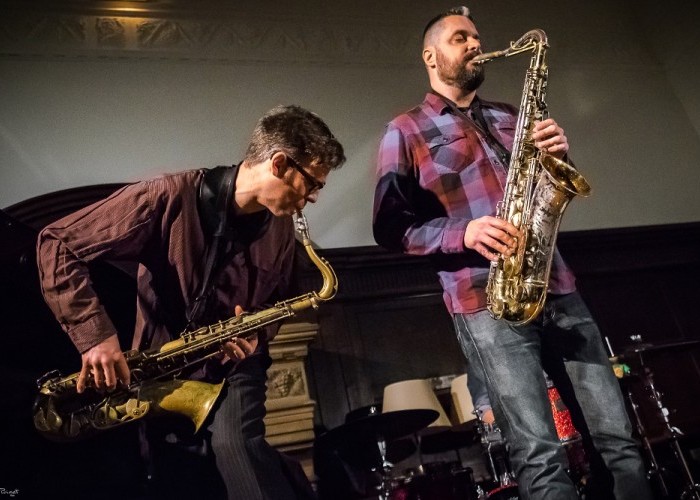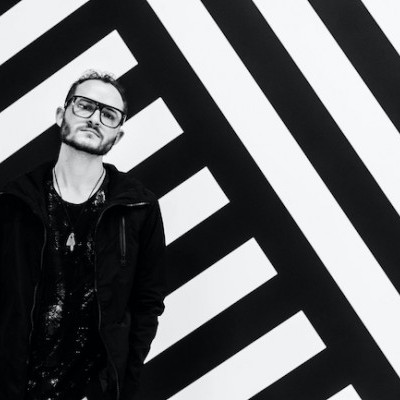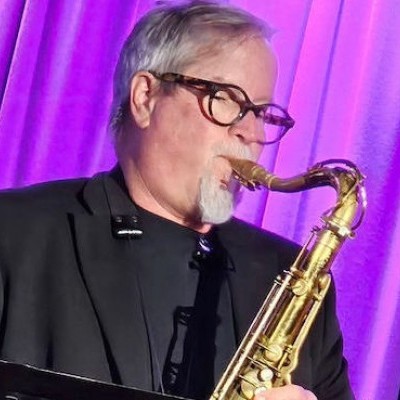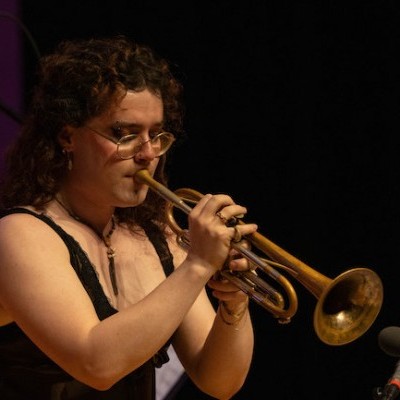Oct 28, 2025 10:47 AM
In Memoriam: Jack DeJohnette, 1942–2025
Jack DeJohnette, a bold and resourceful drummer and NEA Jazz Master who forged a unique vocabulary on the kit over his…

Keefe Jackson (left) and Dave Rempis perform at the Sons d’hiver festival in Paris on Jan. 29.
(Photo: Laurent Poiget)From its modest beginnings in 1991, the Sons d’hiver festival steadily has built an international reputation for presenting adventurous jazz and improvised music, more recently advancing toward hip-hop, electronica, blues and other global sounds.
This 27th edition of Sons d’hiver sprawls over three weeks, concentrated around the Paris suburbs of Val-de-Marne, south-east of the city. Most evenings feature a pair of acts, sometimes contrasting, but usually complementary.
Gigs occasionally are more centrally located, and The Bridge #14 was one of these, a free performance at the Columbia Global Centers, the Montparnasse outpost of the New York university. The Bridge is an ongoing collaboration and exchange program, now in its seventh year. It promotes two-way traffic between North America and France, currently with an emphasis on a Paris-Chicago connection. Maintaining such trans-Atlantic relationships over time is a key element of this program: These are not one-off encounters, but rather ongoing dialogues.
The Bridge #14, which was held on Jan. 29, transported Chicagoan reedsmen Dave Rempis and Keefe Jackson, to improvise with a trio of French players: pianist Christine Wodrascka, and drummers Peter Orins and Didier Lasserre. Playing acoustically, in a medium-sized room, even the twinned drumkits didn’t provide a problem, avoiding the booming reverberences often encountered in such a space. Initially, Rempis played alto saxophone, with Jackson on tenor, leading a foray deep into a maelstrom of sound. There was a little playfulness, as Orins and Lasserre deployed mallets and woodblocks, growing a dense forest of minuscule activity.
For a stretch, the saxophonists played alone, stacking up jostled levels, Orins returning with tiny metallic investigations. Positioned as the odd one out, besides the doubled reeds and percussion, Wodrascka acted alone, making doomy strikes at the low end of the keyboard. She drew sheets of piano resonance that sounded disembodied when battling against the forces of her bandmates. Instead of offering one or two extended pieces, this quintet’s empathy produced a set of shorter outbreaks, operating at a quicker pace than some improvisers.
The raging assault cut to a minimal drum duet, as Laserre launched into intermittent detonation of his bass drum. Wodrascka leaned into her piano interior, scraping and plucking, as Jackson switched to sopranino, although Rempis was flying high, too, his tenor matching the shrill squealing.
The quintet’s second piece, for which Jackson moved to bass clarinet, concluded eloquently, when all players magically shimmered to a simultaneous halt.
Two days earlier, at Théâtre Jacques Carat, in Cachan, the Chicagoan drummer Mike Reed and his People, Places & Things quartet joined forces with the Orchestre National de Jazz, led by guitarist Olivier Benoit. They presented The City Was Yellow: The Chicago Suite, a specially commissioned work from Reed incorporating elements of work by some of the Windy City’s key composers: Hal Russell, Fred Anderson, Rob Mazurek, Ken Vandermark and Nicole Mitchell. This incarnation of the ONJ was dominated by horn players.
A surprisingly swinging momentum dominated the proceedings, driven by the doubled drums of Reed and Eric Echampard. The pianist Sophie Agnel persistently acted as a wild card, viciously striking elbows during an abstract trio sequence, before a monumental horn riff emerged, harmoniously stacked. Paul Brosseau’s Fender Rhodes sounded uncannily close to a cracked guitar, and Ward delivered one of the set’s highlight solos, his alto cavorting, bittersweet, through a gliding note-stream. The full peak arrived with a cascading horn polyphony, followed by an encore of vibraphonist Jason Adasiewicz’s “Rose Garden,” a slow, New Orleans flavored lullaby.
At Espace Jean Vilar, in Arcueil, New York tenor saxophonist James Brandon Lewis and Chicago drummer Chad Taylor played an improvised duo: another set that angled toward concise numbers. After a couple of reasonably untoward pieces of dialogue, Taylor brought out his amplified mbira, its glistening web of sound prompting Lewis to play with a sparser, softer feel. Taylor’s complex patterns shifted emphasis gradually, a sprightly bounce evolving, as Lewis emitted a sweetly burred tone, engaging with the clipped funk accumulation.
This was just one phase of the festival’s extended program, highlighting the bonds and compatibilities between Paris and Chicago. In the coming week, there’s the promise of New York rap, Vietnamese fusion, Japanese turntablism and Detroit techno in addition to all the expected jazz exploration.
For more information about the festival, which runs through Feb. 17, visit the Sons d’hiver website. DB

Jack DeJohnette boasted a musical resume that was as long as it was fearsome.
Oct 28, 2025 10:47 AM
Jack DeJohnette, a bold and resourceful drummer and NEA Jazz Master who forged a unique vocabulary on the kit over his…

“I’ve told students, ‘I don’t mind if you use AI for this or that project,’” says MIT’s Pascal Le Boeuf. “‘But you need to tell me.’”
Sep 18, 2025 11:14 AM
A standard joke when it comes to discussing artificial intelligence, or AI, is that it’s developing so rapidly that…

Chuck Manning Works for NASA … and plays jazz.
Sep 18, 2025 11:23 AM
Congratulations! After years of study, you’ve earned your degree in jazz performance. But let’s face it: Making a…

Always a sharp dresser, Farnsworth wears a pocket square given to him by trumpeter Art Farmer. “You need to look good if you want to hang around me,” Farmer told him.
Sep 23, 2025 11:12 AM
When he was 12 years old, the hard-swinging veteran drummer Joe Farnsworth had a fateful encounter with his idol Max…

“Make time and energy to meet people and make friends,” suggests Millie Ahearn, a student at DePaul University.
Sep 18, 2025 11:32 AM
For many students, the transition into a collegiate jazz program can feel overwhelming — new peers, unfamiliar…